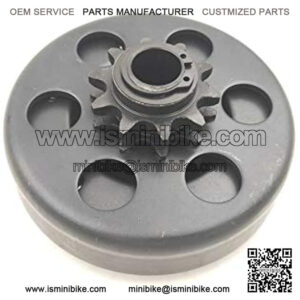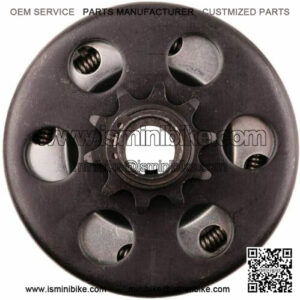In this article, we’ll be taking a more detailed look at 10-tooth vs 12-tooth clutches. I’ll also be providing you with some ideas on how to determine which type of sprocket is best for your mini bike. In summary here are the main topics:
- Number of Teeth
- Gear Ratio
- Chain Compatibility
Number of Teeth
As you can see from the images below, the most popular centrifugal clutches on the market have sprockets that have either 10 or 12 teeth. These teeth are similar to cogs on a cog wheel and can be counted.
The one on the left is a 10-tooth clutch, also known as a 10T clutch, as its clutch sprocket has 10 teeth. On the image on the right side, you’ll see that the 12-tooth clutch, or 12T clutch, has 12 teeth.
The number of teeth a clutch sprocket has, can affect the gear ratio and also determines which type of go-kart chains it is compatible with. Let’s explore these two aspects in a little more detail.
Gear Ratio
The gear ratio of a go-kart, or any other type of vehicle with a chain, is determined by the amount of teeth on the clutch sprocket and the amount of teeth on the rear axle sprocket. To give you a better idea, you can refer to the formula below:
Gear Ratio = Teeth on Axle Sprocket / Teeth on Clutch or Engine Sprocket
The less amount of teeth a clutch has, the higher the gear ratio and the higher the amount of teeth a sprocket has, the lower the gear ratio. The gear ratio, along with multiple other variables, such as engine speed and tire height will determine the speed of your go-kart.
10T Clutch Gear Ratio
Let’s assume that you use a standard 60-tooth rear axle sprocket with a 10-tooth clutch. Below, you’ll see the gear ratio using the calculation above:
- 10T Clutch Gear Ratio = 6:1 (60 divided by 10)
12T Clutch Gear Ratio
Let’s stick with the same scenario above, using a 60-tooth rear axle sprocket. However, this time, we’ll be using a 12T clutch instead. Below, you’ll see the gear ratio using the calculation above:
- 12T Clutch Gear Ratio = 5:1 (60 divided by 12)
As you can see, the 12T clutch has a lower gear ratio at 6:1 compared to the 10T clutch, which has a gear ratio of 6:1. But does a lower gear ratio (higher top speed) mean that a 12T clutch is better? Let’s find out.
Chain Compatibility
Because the sprockets on both 10T and 12T clutches are physically pretty similar in size, the distance between the teeth is different. The distance between the sprocket teeth is also referred to as the pitch. In turn, the pitch determines what chain a clutch is compatible with.
- 10T clutch supports a #40, #41 and #420 chain
- 12T clutch supports a #35 chain
In essence, a 10-tooth clutch has a pitch of 1/2″. This means that it can support #40, #41 and #420 chains (also written as #40/41/420). On the other hand, a 12-tooth clutch only has a 3/8″ pitch, and can therefore only support a #35 chain.
It’s important to understand that there are different chain sizes. Take a look below on how different they are:
- #35 Chain: Small
- #41 Chain: Medium
- #420 Chain: Large
- #40 Chain: Very Large
About mini bike clutch
“mini bike clutch brake”
“mini bike clutch cover”
“mini bike clutch vs torque converter”
“mini bike clutch kit”
“mini bike clutch assembly”


